Author(s): Yonatan Crispel
ABSTRACT
Background: Weaning of mammalian progeny is associated with a change in body shape and physical characteristics. It programs growth, body composition,
and the tempo of physiological and behavioral development and maturation, as well as litter size and parity and, thereby, reproductive strategy.
Methods: To evaluate the impact of weaning from breastfeeding on physiological and behavioral development we use two kinds of tests:
1. Open field test - an experimental test that helps assess motor movement and anxiety versus curiosity in rodents.
2. Object recognition test that tests the ability to identify new objects compared to old ones and in our case tested this memory in the short term.
Results: Early weaning showed significantly better motor movement, better curiosity and memory, and less anxiety than late-weaning animals.
Conclusions: Animals that are weaned early show better cognitive and behavioral processes on a level of curiosity and mobility with better memory and
are less anxious compared to animals that are weaned latez.
Mammalian life goes through a period of infancy, defined mostly by breastfeeding, and subsequently gradual weaning towards an adult diet. We have previously shown that in humans a delayed infancy-childhood transition has a lifelong impact on stature [1-2] and that correspondingly in the rat, the age at weaning from lactation determines a rat’s growth trajectory, but also body composition and maturational tempo [3]. We showed that early-weaned rats developed faster than normal than late weaned rats; as day 30 and until adulthood early weaned were leaner and longer than late-weaned animals, which were heavier and shorter [3-4]. Early-weaned progeny mature more rapidly, females showed earlier vaginal opening and estrous and males showed earlier onset of testicular growth [3,5]. Weaning from lactation is responsive to sex, stress, and other environmental cues that are presumed to inform the developing organism about risks and opportunities in its current and future environment [6]. The weaning age defines life history transition from infancy to childhood in humans and to juvenility in the rat and this transition phase is highly important in shaping (programming for) future growth and maturation trajectories [2,7-8].
In early studies, we showed that the age at weaning from lactation regulates a rat’s life history, growth, body composition, and maturational tempo. Also, we show that early-weaned rats developed faster than normal or late-weaned rats; they are leaner and longer than late-weaned that found heavier and shorter. Early weaned progeny develop more rapidly (that is, fur budding, pinnae detachment, eye-opening); females show earlier vaginal opening and estrous and males show earlier onset of testicular growth. In generations, three and four, early-weaned rats bear larger litter sizes and heavier newborn pups. The entire traits complex is transmitted to subsequent Generations from the paternal side [3,5]. Here, we examined the impact of weaning age on behavior, stress, memory, and anxiety from birth, and compared groups that weaned from lactation. Early weaning is 16 days and late weaning is 26 days.
The animals that we used for the present report have been previously described in detail [3]. In short, gestating outbred Sprague–Dawley mother rats from timed pregnant colonies were housed at the Animal Facility of the Rappaport Faculty of Medicine, Technion Haifa, Israel. All animal procedures were approved by the Technion Animal Use and Care Committee and were performed under the supervision of an experimental animal veterinarian surgeon. Normally rats are weaned at day 21 (d21) of life and therefore such rats in all groups served as controls. The number of female pregnancies used for replicates in each weaning group was three, to provide 12 males and 12 female pups per group. Animals were grown uninterrupted other than for weekly measurements until weaning on the designated day 16 (d16; early weaning) or d21 (control). On weaning day, mothers were removed, and non-lactating cross-foster mothers that had weaned litters successfully in the recent month were introduced as foster mothers [9]. Upon weaning on d16, both chow cubes and chow powder were introduced to cages to ascertain ad lib feeding by young pups. A second group of rats that had been weaned by cross-foster mothers on d16 (early weaning), d21 (normal weaning), or day 26 (d26; late weaning). All were separated from foster mothers on day 30.
We, therefore, want to examine whether weaning from breastfeeding at the various stages affects the critical transition stages in growth, physiological development, sexual maturation, behavior, and cognition and whether the changes pass between generations. In this study, we examine two subjects: first, if early weaning from breastfeeding will accelerate development towards adaptation to environmental conditions. Second, if rats weaned early from Breastfeeding will develop unsafe behavior compared to rats weaned late.
To test these hypotheses we performed three main tests:
Open field test (OFT) a behavioral test developed by an American psychologist - Calvin S. Hall. This is an experimental test that helps assess movement and anxiety in rodents in laboratory tests [10].
This test relies on two basic instincts in rodents - the urge to explore a new environment versus the fear of exposed/open spaces. The information obtained from this test is quantitative and qualitative [11].
Open field test - A box consisting of a board surrounded by walls to prevent escape, the board is marked with lines forming 16 equal squares, its purpose is to allow monitoring of motor behavior - frequency of crossing lines, urgent visits to the main squares and standing on hind legs, are signs of motor activation and curiosity as well as safe behavior in the new environment. Signs such as - walking in the center of the box or next to the walls indicate differences between curiosity and confidence versus anxiety and insecurity, this measure is measured in the first three minutes in the box [12].
This test is considered simple and basic and is widely used in laboratory studies dealing with rodent behavior, especially after manipulations that may affect this behavior [13].
Dimensions of the box Length 60 Width 60 Height 40 cm The box is divided into 16 equal squares in an area of 15 cm each, a total of 4 squares in the center and 12 adjacent to the walls of the box. An innovation we introduced in this study is the monitoring of the different life stages of open field behaviors (Chart 1 and Chart 2). From age 22 days, weekly to age 60 days we examined eight males and eight females from each group to assess differences between groups, between sexes, and to see behavioral changes as a function of life stage development as reflected from this test.
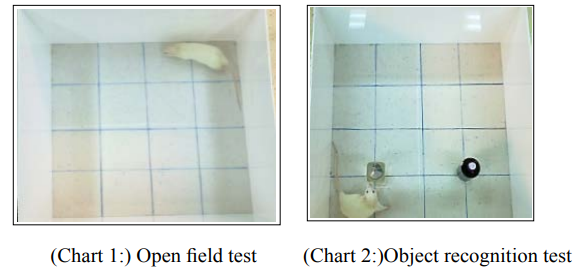
Statistical analysis Physiological data were analyzed using SAS 6.12, utilizing 1-way ANOVAs. Comparisons between cases were analyzed by nonparametric test followed by a corrected Mann–Whitney U test for multiple comparisons. Differences with 2-tailed p values < 0.01 vs. d16). Short-term effects of early weaning the first series of experiments examined the short-term effects of early weaning (d16) on rats’ behavior compared with still suckling rats.
Long-term effects of early weaning the second set of experiments examined the long-term effects of early (d16), normal (d21), and late weaning (d26) on adult animals’ Statistical Analysis: Physiological data were analyzed using SAS 6.12, utilizing two-way ANOVA. Histomorphometric data were analyzed using SPSS 6.0 (Chicago, IL). Comparison between cases used the nonparametric Kruskal-Wallis ANOVA followed by a corrected Mann-Whitney U test for multiple comparisons. Differences with 2-tailed P values < 0.05 were considered significant.
In this study, we examined three generations and compared early weaning on day 16 to day 26 late weaning. In the first generation, the result was not significant. Second generation and third generation the results were significant (p<0.05), between early weaning on day 16 to late weaning on day 26. We present in graphs only the result of the second and third generation.
Open field test for males and females, no significant differences were found between groups at 16 days and 26 days, at 22 days two groups are less active until 36 days of age they reach already the peak of motor activation, and from there is a decline that lasts until 60 days of age.
In a test that examined differences between anxiety versus curiosity no significant differences were found in males and females weaned on day16 and males and females weaned on day 26, Both groups showed more anxiety at 22 days of age and it was evident that they preferred to be in the periphery of the box. At the age of 29-36, they dared to enter the center more. From the age of 36-60, they entered the center less, perhaps because there was also a decrease in general activation.
In the second generation, there are significant differences between males from the 16-day group and the 26-day group. Males who were weaned earlier and began to develop earlier were able to perform motor movement earlier - they crossed 71 lines in three minutes compared to 58.4 in males who were weaned later (p <0.05). These gaps narrowed at age 29 days, but recurred and remained significant throughout all tests until age 60 days (Figure 1A).
In the first three weeks, no significant differences were found between females weaned at 16 days of age and females weaned at 26 days of age. From the age of 43 days and in the last three tests, significant differences (p <0.05) were found in crossing lines indicating motor activation (Figure 1B).
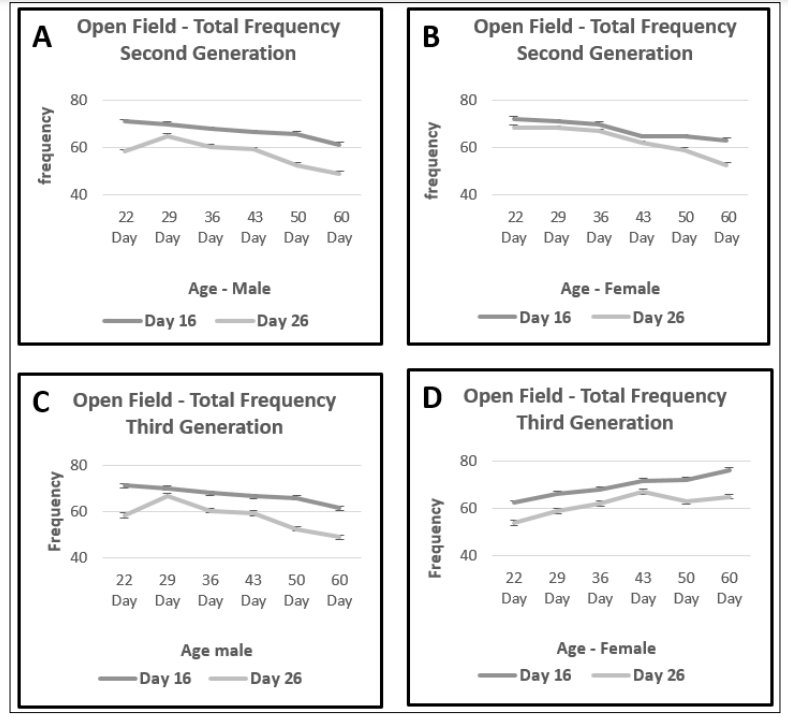
Figure 1: Males and Females who were weaned earlier and began to develop earlier were able to perform motor movement earlier Differences between group’s, A – C Male B – D Females, day16 & day26 Second and third generation *p<0.05
In the third generation, there are significant differences between males from the 16-day group and the 26-day group. Males who were weaned earlier and began to develop earlier were able to perform motor movement earlier - they crossed 72 lines in three minutes compared to 60 in males who were weaned later (p <0.05). These gaps narrowed at age 29 days but returned to be significant at age 43 - 50 and 60 days (Figure 1C).
Females who weaned earlier and began to develop earlier were able to perform motor movement earlier - they crossed 77 lines in three minutes compared to 65 in females that weaned later (p <0.05). These gaps were significant at 22 days of age, at 29-36 days of age the gaps narrowed and did not remain significant, but returned to be significant at age 43 until 60 days (Figure 1D).
In a test that examined anxiety versus curiosity, significant differences were found between males in group 16 and males in a group 26 days. In the first two tests - age 22 and 29 days early weaned rats stayed in the center of the board longer than late weaned rats the difference was significant (p <0.05). From the age 36 the gaps narrowed and did not remain significant, but returned to be significant at age 43 (Figure 2A).
In the first test, early-weaned rats stayed in the center of the board longer than late-weaned rats the difference was significant (p <0.05). From the age of 29 to 36, the gaps narrowed and were not significant, in day 36 to day 43 is was significant differences between groups, and from day 50 to day 60 the gaps narrowed and were not significant (Figure 2B).
In a test that examined anxiety versus curiosity, significant differences were found between males in group 16 and males in group 26 days. In the first test age of 22-29 days, the gaps were significant rats weaned early stayed in the center of the board longer than rats weaned late, the difference was significant (p <0.05). And from 36 days of age, the gaps narrowed and were not significant, but returned to be significant at age 43 (Figure 2C).
In the first two test, ages 22 and 29 days found significant differences between groups. From day 36 the gaps narrowed but returned to be significant at age 43 and 50 days. (Figure 2D).
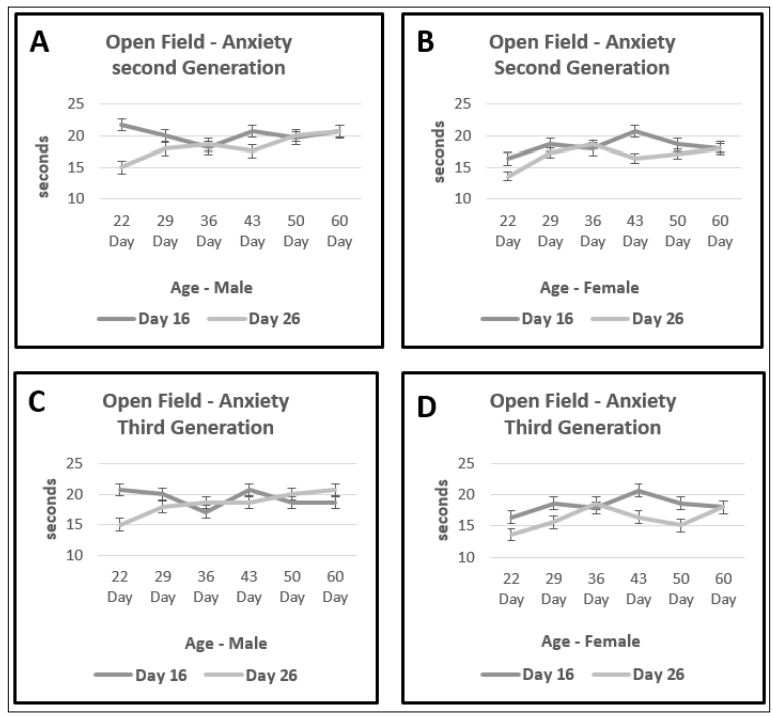
Figure 2: anxiety versus curiosity, Differences between group’s, male A – C and Females B – D day16 & day26 Second and third generation *p<0.05
In a test for the detection of new objects, that tests short-term memory in males, significant differences were found between the 16-day group and the 26-day group. At age 29, the gap narrowed and reopened at age 43 until day 60. Even at these ages, the gap was significant (Figure 3A).
In a test for the identification of new objects examining short-term memory in females, significant (p <0.05) differences were found between the 16-day group and the 26-day group. at 43 and 50 days early weaned rats were more seconds near the new object at 18.4 and 18.5 seconds in early weaned rats compared with 15.5 and 14.1 seconds (respectively) in late weaned rats (Figure 3B).
In a test for the detection of new objects, that tests short-term memory in males, significant differences were found between the 16-day group and the 26-day group. All the test from day 22 to day 43 was significant at age 50 day the gap narrowed until age 60 day (Figure 3C).
In a test for the identification of new objects examining short-term memory in females, significant (p <0.05) differences were found between the 16-day group and the 26-day group. tests at age 22 and 29 were not significant, from day 36 the gaps reopened until the end age 60 day and were significantly (Figure 3D).
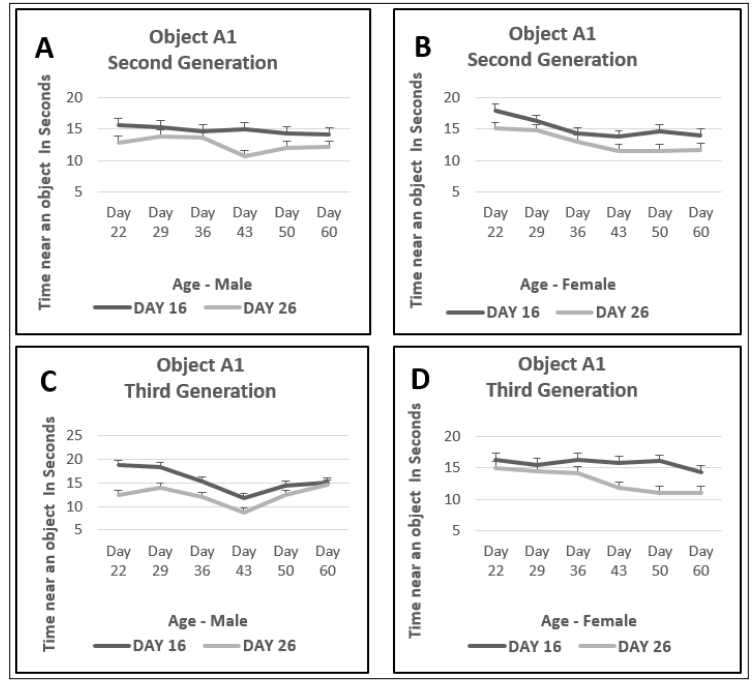
Figure 3:Time near same object A1 in seconds, differences between male and females group’s A – C Male B – D Females, day16 & day26 Second and third generation *p<0.05
In a test for the detection of the same objects that test short-term memory in males, significant (p <0.05) differences were found between the 16-day group and the 26-day group. from age 22 to age 29 the gap narrowed and was not significant, and reopened at age 36 until age 60 day and was significantly (Figure 4A).
In a test for the identification of the same objects that tests short-term memory in females, significant (p <0.05) differences were found between the 16-day group and the 26-day group. In the first two tests, age 22 and 29-day differences between groups found not significant. from age 36 to age 50 the gap reopened and was significant (Figure 4B).
In a test for the detection of the same objects that test short-term memory in males, significant (p <0.05) differences were found between the 16-day group and the 26-day group. from age 22 to age 29 the gap narrowed and was not significant, and reopened at age 36 until age 60 day (Figure 4C).
In a test for the identification of the same objects that tests short-term memory in females, significant (p <0.05) differences were found between the 16-day group and the 26-day group. In the first two test age 22 and 29 days found not significant differences between groups. from age 36 to age 50 days the gap reopened and was significant (Figure 4D).
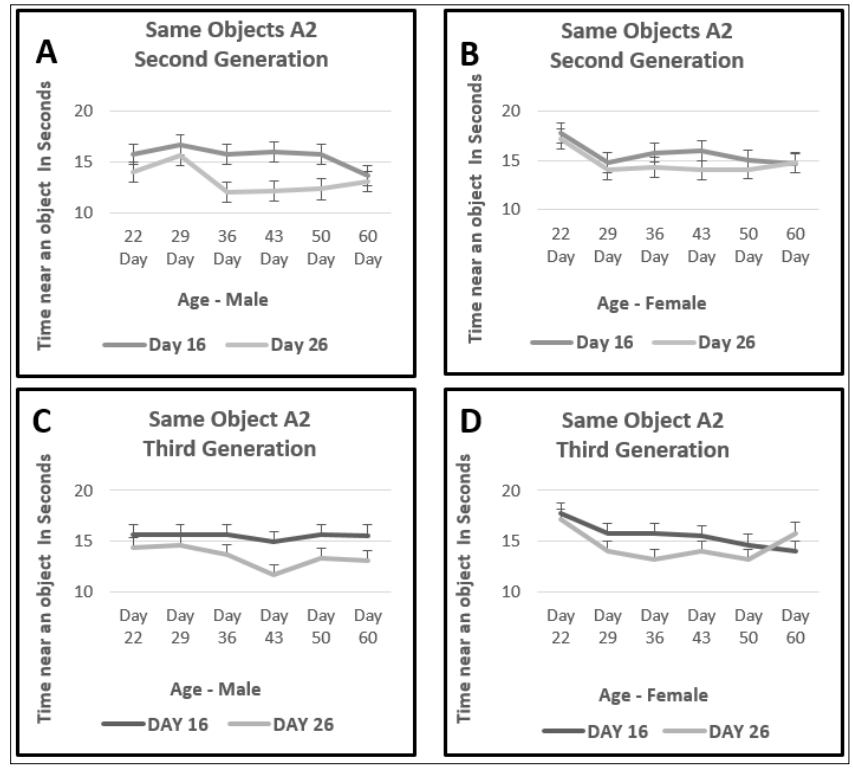
Figure 4:TimenearsameobjectA2inseconds,differencesbetweenmaleandfemalesgroup’sA–CMaleB–DFemales, day16 & day26 Second and third generation *p<0.05 Object Recognition Second Generation Timeneardifferentobject B2Male
In a test for the detection of different objects, that tests short-term memory in males, significant (p<0.05) differences were found between the 16-day group and the 26-day group. from age 22 the gap was significant, at age 29 the gap narrowed and reopened at age 36 until age 60 day, even at these ages, the gap was significant (Figure 5A).
In a test for the identification of different objects examining short-term memory in females, significant (p <0.05) differences were found between the 16-day group and the 26-day group. from the first test at age 22 days until age 60 day early weaned rats were more seconds near the new object 19.3 and 18 seconds in early weaned rats compared with 16.7 and 11.1 seconds (respectively) in late weaned rats (Figure 5B).
In a test for the detection of different objects, that tests short-term memory in males, significant differences were found between the 16-day group and the 26-day group. on the first test on day 22, the gap was significant from age 29 and age 36 day the gap narrowed and from day 43 the gap reopened until age 50 day (Figure 5C).
In a test for the identification of different objects examining short-term memory in females, significant (p <0.05) differences were found between the 16-day group and the 26-day group. test at age 22 was significant from age 29 until age 36 days the gap narrowed and reopened until the age 60 days (Figure 5D).
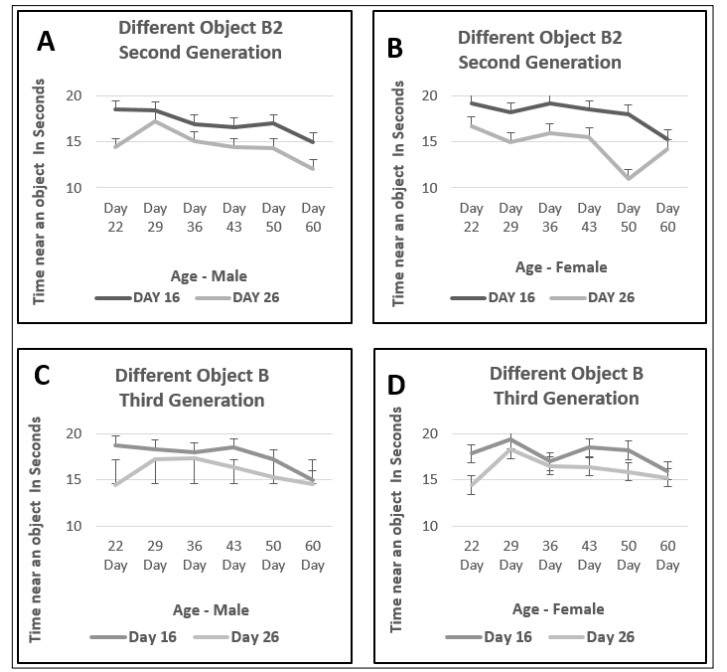
Figure 5: Time near different object B2 in seconds, differences between male and females group’s A – C Male B – D Females, day16 & day26 Second and third generation *p<0.05
In most mammals, the relationship between mother and baby ends when the offspring are weaned from breastfeeding. However, the duration of suckling in nature varies widely in the context of physiological development, as well as varies according to sex, species, stress, certain circumstances, and environment. These factors largely determine the extent of the relationship and its duration [6,14-15].
Many studies have found that breastfeeding is not just a transition from breastfeeding to digesting solid foods it is a unique, critical, and irreversible transition that has implications for behavior in adulthood, so intervention at this stage has lasting effects [6,16-17].
Growth and development in mammals and infants, in particular, depend on the brain’s transition phase. in humans, there are four phases, and in other mammals, there are three phases, the transition from phase to phase depends on many factors including environmental processes, stressful situations, nutrition, the duration of weaning from breastfeeding, the relationship with the mother [3,7].
In previous studies, we have shown that the age at weaning from lactation regulates a rat’s life history, growth, body composition, and maturational tempo. We show that early- weaned rats developed faster than late-weaned rats; they are leaner and longer than late-weaned ones who are heavier and shorter. Early-weaned progeny develop more rapidly (that is, fur budding, pinnae detachment, eye-opening); females show earlier vaginal opening and estrous and males show earlier onset of testicular growth. In generations three and four, early-weaned rats bear larger litter sizes and heavier newborn pups. The entire traits complex is transmitted to subsequent generations from the paternal side [3].
The explanation behind this change is the hypothesis that weaning age programs the tempo of development. animals weaned earlier feel they are in a less safe world and do earlier programming of the transition from infancy to the juvenile in the brain. Early weaning forces the puppies to go out and look for food on their own in order to survive, so they are more active, more fertile, and strive to leave offspring faster since their environment is less safe compared to animals weaned later [7,3]. In this study, it can be seen that early weaning affects behavior, anxiety, and memory as shown in the graphs and results. We hypothesize that the main finding is an epigenetic biological mechanism. This comparison was found to be significant over four generations and the assumption is that the cause is an epigenetic process that preserves the changes over a limited number of generations without affecting the structure of the genome itself.
This mechanism is passed down from generation to generation by the manipulation, of early weaning from breastfeeding and passed on to future generations. This explanation is based on the hypothesis that examines changes and epigenetic differences as well as changes made through the mediation of growth and development hormones [18].
The transition from infancy to childhood is cross-cultural and passed down from generation to generation. DNA methylation in the various stages of pregnancy is well documented in the professional literature, what happens in the critical stages of postpartum life is a mystery; the reason for this is the common assumption that DNA methylation during pregnancy is a process that defines the genome in such a way that determines A lifelong path. Newer studies show that DNA undergoes additional methylations after birth observed changes in DNA methylation during infancy, and shows that the methylation is very sensitive and changes in relation to the treatment from the mother [19].
We, therefore, hypothesize that the transition from one stage in life history to another involves new epigenetic programming of genome functions possibly this mechanism is the mechanism of the transition. We hypothesize that social and fiscal circumstances in our environment reshape the epigenome, and this is an adaptive mechanism of the genome during the transition period from infancy to childhood. This process reflects on the mental and physical health of the baby in adulthood, understanding this process is important to understand how life events, especially in the early years, shape and affect us and our quality of life in adulthood [17].
It has been found that the duration of breastfeeding and the nature of weaning can be a cause of obesity at an older age, but this relationship is divided into studies dealing with breastfeeding, especially in developed countries [20]. When examining the effect of breastfeeding on development one should consider all the variations that affect the baby’s diet and examine how they affect the growth rate, the transition to childhood, and the body structure [21].
Mammalian development is divided into the pre-natal period, lactation, and lactation weaning, each period varying in the way food is consumed and its composition [18]. The transition in animals from breastfeeding to solid food (weaning) is gradual and characterized by adaptation to the environment and circumstances.
The personal developmental history of each result in the development of structures that are unique to the same organism, differentiate it from its own species and causes the genotype of that individual to be expressed differently and uniquely from its own species, the living organism adapts to its environment and changes according to the environment. Each genotype has the ability to create a different phenotype in changing environmental conditions it is the plasticity trait of the organism that causes it to change, depending on the environment, and thus have a higher chance of surviving and producing successful offspring.
Expression of genes in the transition stages from infancy to childhood and in the early stages of development is responsible for the creation of plasticity and from it the various structures that adapt to each organism. The environmental conditions experienced by the organism in the early years of its life are crucial conditions that will affect a person’s biology, health, and behavior in the future. [21]. There is evidence that collected from studies and found to support the fact that nutrition and stress during infancy will greatly affect the normal development and metabolism in the adult.
In humans, the theory is expressed, among other things, that the timing of the transition between infancy and childhood and its delay has a great influence on developmental social, emotional and cognitive characteristics, such as the height of the organism, its IQ level and its educational function in childhood-adulthood. One of the theories that reflects human behavior in childhood and influences him in adulthood is the attachment theory as it appears in John Bowlby’s attachment theory called also the adaptation theory. The English psychiatrist John Bowlby sought to combine the emotional, social and cognitive aspects of development in his theory [22-24].
According to attachment/adaptation theory, the acquisition of mental structures generates fundamental changes in the child’s involvement in the world and in shaping his behavior because of accumulated life experience. The child is seen as an active information processor in order to guide his social behavior. This theory comes to connect the emotional aspect together with the social and cognitive aspects of development. The starting point is the idea that babies are predisposed to behave in ways that encourage closeness with those who care for them, along with the psychoanalytic idea that the quality of attachment between a toddler and an adult is greatly influenced by the quality of care that the infant experiences. Although both the tendency for attachment and the stages of their development are universal, the security afforded by these engagements may differ greatly.
A toddler whose caregivers meet his needs will develop a belief that he can influence the environment and receive care from others when he needs it. During development, children who derive security from their attachments will develop a general belief that they will be able to successfully overcome life’s obstacles.
On the other hand, toddlers whose caregivers do not respond to their needs and do not derive security from their attachments may be dependent and doubt their abilities, and may even be isolated from society or aggressive. These include babies and toddlers who push them to independence at too early an age.
Bowlby’s theory attributes an important role to cognition and learning. During long hours of interaction with their caregivers, the babies develop generalized expectations about the caregivers’ reactions and about their role in creating these reactions. Bowlby called these expectations an internal action model and claimed that once such models are created, they guide relationships in the future. By participating in a responsive relationship, the baby learns not only that his caregiver is available and responsive to his needs, but also that this is how relationships work. The baby will apply the acquired patterns in many contexts later in life. The quality of the relationship between the mother, baby and the consequences, of the childhood period are considered critical for adjustment and adaptation to social society in the adult, this relationship has been extensively studied in humans and in animal models of weaning and changing environmental conditions [6,16,25].
Two types of parenting can be presented - parenting that is sensitive enough to the child’s needs and parenting that is not sensitive enough to the child’s needs. Sensitive parenting leads to a secure attachment, while insensitive parenting is divided into two types - ambivalent parenting (sometimes the child’s needs are addressed and sometimes not) and avoidant parenting the child is denied care. Del Giudice developed Bowlby’s model and connected it to the stages of development, showing that in an insecure attachment, boys will adopt a strategy of avoiding and girls building a strategy of anxiety this model illustrates the effects of the environment during a critical period on the person in adulthood [26]. There is still a lack of systematic studies which examine the sequence of developmental stages as they occur in the natural environment [27]. The transition from one stage to another in the history of life requires a certain mechanism that will allow the next stage to exist, so we have raised epigenetics as a mechanism and weaning as a catalyst. An important and basic premise in the study is that the traditional definition of weaning from infancy is that weaning from breast milk is a physiological and metabolic process and the transition from infancy to childhood has a crucial evolutionary and environmental impact [18].
In the current study, we expected that animals that were weaned earlier would be insecure, because they are in a less safe world, and therefore would be more anxious, and would tend to be more introverted with less mobility and curiosity. To our surprise, we got the opposite results, in all parameters so animals that were weaned earlier were more curious, more mobile and safety, compared to animals weaned later. This process could partially explain why the early-weaned animals were larger, leaner with better BMI, and less prone to diabetes. The animals weaned later were shorter and fatter in length with less mobility with high BMI and tendency to diabetes.
In conclusion, early weaning affects the plasticity of the brain, causing epigenetic changes to manifest in a different psychological, behavioral, and physiological personality structure than late weaning. This study is another step in the series of studies we have carried out that shows the importance of weaning from breastfeeding and the importance of the duration of breastfeeding [28-31].
